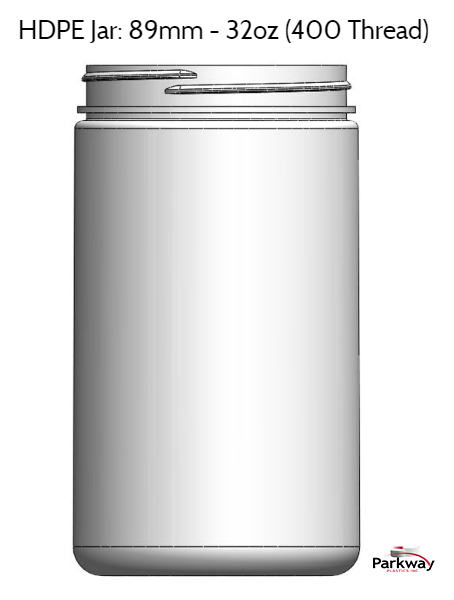 Loading... Please wait...
Loading... Please wait...Blog - Polymer
Common Uses, Advantages and Disadvantages, and FAQs about HDPE Plastic Packaging
Posted by Tegan James on 11-14-2019
Common Uses, Advantages and Disadvantages, and FAQs about HDPE Plastic Packaging 
The following article points out some common uses, as well as the advantages and disadvantages of of HDPE. (1)
HDPE is recyclable and "great for blow-molding applications, particularly food and beverage containers because it won't leach into the bottles' contents.
High-density polyethylene or HDPE is a commonly used petroleum thermoplastic and the most used of the three polyethylenes for a wide range of applications. If you look at this plastic under a microscope, you would see that it has a linear structure with few branches lending to its optimal strength/density ratio. As a result of its molecular makeup, this polymer shines brightest in applications where moisture resistance and cost-effectiveness are needed.
HDPE was created in the 1930s and used in high-frequency radar cables during World War II. It was introduced to the market commercially soon after. While its higher density versions yield a more rigid result, HDPE can vary in flexibility. Low-density grades of the thermoplastic are less stiff and the high-density grades have equally high crystallinity.
The Advantages and Disadvantages of HDPE
Even with its popularity, there are some advantages and disadvantages you should consider before using HDPE for your application:
Advantages
- Cost-effective
- Can withstand temperatures from -148 to 176 degrees Fahrenheit
- Non-leaching
- UV-resistant
- Dishwasher safe
- Resistant to most chemical solvents
- Stiff material
Disadvantages
- Poor weathering resistance
- Flammable
- Sensitive to stress cracking
- Difficult to bond
4 Common Uses for HDPE
- Plastic bottles: Most people are informally introduced to the durable plastic through water bottles. HDPE is great for blow-molding applications, particularly food and beverage containers because it won’t leach into the bottles’ contents. In addition, HDPE is recyclable which makes it a great choice for these highly disposable products.
- Toys: HDPE is UV resistant which helps keep the toys resistant to the ray’s damaging and discoloring effects.
- Chemical containers: With its chemical resistant properties, HDPE is great for laundry, shampoo, conditioner, household cleaning products, motor oil, antifreeze and recycling bins. The strength of these bottles is increased when they’ve been colored or pigmented.
- Pipe systems: HDPE pipe grade sheet has a higher molecular weight compared to the standard HDPE used in the above examples. This strengthening with its UV-resistance makes it ideal for piping and outdoor applications. Pipe grade sheet has the ability to withstand -220 to 180 degrees Fahrenheit. It’s durable in most chemical interactions which make it useful in a lot of industrial applications.
Parkway Plastics offers HDPE Pails (Buckets), HDPE jars, and HDPE bottles to suit a wide range of applications:

If you have any questions about Parkway's line of HDPE products, contact us!
The Advantages of HDPE Include
- Affordable
- High-Quality
- Operate and Harsh Temperatures
- Non-Leaching
- UV Resistant
- Resistant to most Chemicals
- Stiff Material
- Amazing Durability
- Highly Versatile
The Disadvantages of HDPE Include
- Poor Weathering
- Highly Flammable
- Sensitive to Stress Cracking
- Not Biodegradable
- Can't Be Composted
- Not Resistant to Oxidizing Acids
- Not Resistant to Chlorinated Hydrocarbons
- High Thermal Expansion
- Poor Temperature Capability
The Top Uses for HDPE Include
- Shampoo Bottles
- Toys
- Chemical Containers
- Pipe Systems
- Milk Jugs
- Recycling Bins
- Grocery Bags
- Cereal Box Liners
- Flower Pots
(1)
Frequently Asked Questions About HDPE
Is HDPE Plastic Safe?
HDPE products are safe and are not known to transmit any chemicals into foods or drinks, making this plastic a low health risk variety, according to Chemical Safety Facts. This plastic is most often used for milk or water jugs, laundry detergents and shampoo bottles. (2)
Are HDPE bottles BPA free?
High-density polyethylene (HDPE) is, like BPA, a material derived from petroleum. The difference is that HDPE plastics are completely free from BPA and are therefore safe for applications that directly impact humans.
Are HDPE bottles recyclable?
* We aim to keep our information accurate. If there is anything requiring an update, we appreciate your time in letting us know, so we can promptly correct it! You may contact us at it@parkwayjars.com.
__________
1 - https://www.acplasticsinc.com/informationcenter/r...
2 - https://www.livestrong.com/article/158674-which-plastic-containers-can-i-safely-use/
Recent Posts
- » Buy Custom Plastic Jars Direct from Manufacturer - Parkway Plastics
- » California Packaging Regulations and You! How does Parkway stack up? Parkway Plastics Meets CA Rigid Plastic Packaging Container Laws!
- » Blow Molding Explained - How PET Jars and Containers are Manufactured!
- » How Reusable Packaging Can Help Improve Your Brand Image & Costs | Safe Plastic Jars for Reuse | Optimize Your Supply Chain with Reusable Plastic Jars and Packaging |
- » Parkway Now Offers Child Resistant Closures | CRC |



